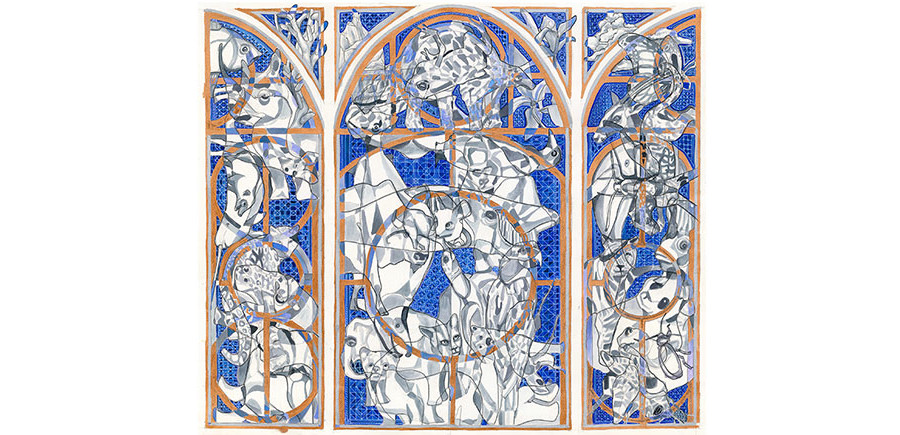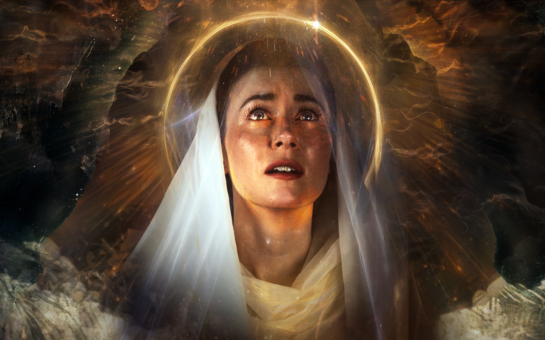Composer Sarah Kirkland Snider’s Mass for the Endangered, the fourth recording in a partnership between New Amsterdam and Nonesuch Records, was released on September 25, 2020. Snider’s Mass features text from the Latin ordinarium interspersed with original poetry by Nathaniel Bellows, and both celebrates and elegizes the natural world, appealing for greater awareness, urgency, and action toward its stewardship.
Originally commissioned by Trinity Church Wall Street in New York City, this recording features the English vocal ensemble Gallicantus conducted by Gabriel Crouch. Deborah Johnson and CandyStations have created music videos for the mass' Kyrie, Alleluia, and Sanctus/Benedictus movements. The piece will also have its European Premiere November 15, with the Latvian Radio Choir at the Concert Hall “Latvija” in Ventspils.
Watch
Snider explains, “The origin of the Mass is rooted in humanity’s concern for itself, expressed through worship of the divine — which, in the Catholic tradition, is a God in the image of man. Nathaniel and I thought it would be interesting to take the Mass’s musical modes of spiritual contemplation and apply them to concern for non-human life — animals, plants, and the environment. There is an appeal to a higher power — for mercy, forgiveness, and intervention — but that appeal is directed not to God but rather to Nature itself.”
Growing up in Princeton, NJ, the one-time home of the American Boychoir School, Snider attended that venerable institution’s co-ed summer camp as a youth: “I attended for five summers. I fell in love with choral singing there, and later sang with the Princeton High School Choir, which was at the time one of the most celebrated high school choirs in the country. These experiences were profoundly formative for me, and I learned a lot of the choral repertoire. I felt very at home in that music, but I hadn’t yet had a chance to explore it in my writing in a significant way. The Mass was my first large choral commission, and I was thrilled to immerse myself in memories of singing the Mozart, Brahms, and Fauré Requiems, the Palestrina and Byrd Masses, and the Bach chorales.
“Rather than consciously upend those traditions,” she continues, “I wanted to open the gates in my mind between centuries-old European vocal traditions and those of more recent American vernacular persuasion, and write from a place where differing thoughts about line, text, form, and expression could co-exist.”
Listen
Press
At a time when singers, especially choristers, are the hardest hit musicians, a glorious choral album from composer Sarah Kirkland Snider renewed my faith in humans joining in song for purpose and strength. Mass for the Endangered might be inspired by the traditional Catholic mass but Snider's 21st-century twist focuses not on our relationship to God, but instead to the flora and fauna on our planet. With layers of sweet and tangy harmonies, shooting out in radiant beams, Snider must be recognized as one of today's most compelling composers for the human voice.
Tom Huizenga, Deceptive Cadence, NPR Classical
21st December 2020
[one of] 10 reasons to keep falling for classical music
Zoë Madonna and Jeremy Eichler, Boston Globe
16th October 2020
Snider asserts her own musical personality as a composer who knows instinctively how to write for the human voice, as she demonstrated in two previous sophisticated song cycles.
Tom Huizenga, Deceptive Cadence, NPR Classical
28th September 2020
By turns diaphanous and urgent, exultant and wary, the music both immerses us in this perilous era and stirs us to examine our collective conscience…
Snider's music in the Credo, the most richly composed and colorful section of the piece, meets the febrile character of the language. The voices are set off against each other in shifting patterns of contrapuntal complexity. The orchestral music builds a driving upward momentum, culminating in a swirl of woodwinds that suddenly, achingly dies away.
The composer is very good throughout at combining solid musical architecture with splendid atmospherics. An oscillating piano figure, which serves as gentle ramp into the Kyrie that opens the piece, recurs near the end, in the Agnus Dei. Other motifs surface in subtly shaded guises. Some are furtive and wispy, others percussive and proud.
Snider, who is perhaps best known for her 2010 song cycle Penelope, writes gorgeously for the fine singers of Gallicantus. Some of her long, sweetly harmonized phrases harken back to earlier sacred works. Bach, Byrd, and Britten can be detected in the work's musical DNA. But there's nothing derivative or borrowed. Harmonies pile up in chromatic clusters, then break free in vaulting solos and murmurous choral meditations.
Each section has its own distinctive character. The Gloria, sung in Latin, is full of restless melodies over a delicately pointillist orchestral fabric. Pulsing strings and gently strummed chords give the Alleluia its gentle sway. The Sanctus makes a lovely male solo the kernel for a discursive development.
Yet there's also a unity of purpose, a sense of inevitable flow through all the variety. Anything but a dogmatic eco-Mass for like-minded listeners, Snider and Bellows's collaboration is a meeting of questing, unsettled minds.
Steven Winn, San Francisco Classical Voice
25th September 2020
Riveting.…A cohesive, 44-minute work in six movements, Mass marries sighing vocal lines of the sort associated with Renaissance madrigals to pulsating minimalist rhythms. The music is set to Latin text from the traditional Catholic Mass combined with an evocative libretto by poet Nathaniel Bellows.
In the impressive opening Kyrie, a catchy ostinato in the piano and a slow, wistful interlude for strings pave the way toward an impassioned choral entreaty that crests and recedes like ocean waves. There is a solemn Gloria with harp and marimba accompaniment, and an ironically titled Alleluia that somberly enumerates our environmental sins. If the Credo, whose repetitive 'I believe' statements elevate nature over its Creator, is the musical climax of Ms. Snider's Mass, the concluding Agnus Dei is its emotional heart — elegiac and affecting.
Barbara Jepson, Wall Street Journal
24th September 2020
As with Snider's past works, the surface details of this Mass can be quickly identified as mellifluous and engaging. But there are additional levels to enjoy. During the Kyrie, her affection for American minimalism is clear when insistent string writing powers the vocalists' polyphonic plea for "mercy to all creed and claw."
Equally telling is a moment in Snider's Credo — as greater complexity gives way to homorhythmic writing on the words "to change how we have lived." This emphatic articulation of purpose, sung by and for other humans, seems to be reaching beyond environmentalism and toward morality at large. The moment also calls to mind the Credo in the Mass for Five Voices by William Byrd, a Renaissance composer whose influence Snider has cited when discussing the album.
Seth Colter Walls, The New York Times
24th September 2020
Expressively interpreted by Gallicantus, an English choral ensemble, and captured beautifully in a recording jointly released by New Amsterdam and Nonesuch, the work proclaims Snider's technical command and unerring knack for breathtaking beauty.
Steve Smith, The New Yorker
24th September 2020
This most accessible and very contemporary work (which just might be the first vegan mass) is deeply grounded in earlier traditions and will be of certain interest to lovers of high-quality choral writing.
Lisa MacKinney, Limelight
23rd September 2020
…so sincere and eloquent in its absorption of the great masses of the past by Bach, Palestrina, etc. — and so sheerly gorgeous — that it is undeniably uplifting…sublime counterpoint and expert architecture.
Jeremy Shatan, An Earful
29th August 2020
The mass makes use of original text by Nathaniel Bellows alongside the traditional Latin liturgical text of the ordinary and according to the composer “embodies a prayer for endangered animals and the environments in which they live.” Conductor Kelly Corcoran was careful to balance the timbral distinction of the orchestration with the vocal lines, allowing the subtle colors and textures to emerge without overshadowing the singers. The dynamic strength of the entire ensemble was reserved for the work's true tutti statements, allowing these sections to function as musical arrivals giving the work a sense of pace. Snider's work often features timbral exchanges between the choral and instrumental voices, requiring meticulous intonation throughout a wide dynamic range. These were handled nearly seamlessly, which even under ideal circumstances is difficult, but in a fairly dry acoustical environment this was doubly impressive. I was particularly enamored with the conclusion of the Kyrie, which featured a long sustain in the female voices that slowly faded to niente accompanied by a reverent, sparsely pulsing statement in the strings. This aesthetic gesture was revisited in a slightly different fashion to end the Agnus Dei, giving the work a sense of closure. These kinds of tapered and delicate endings can be deceptively difficult, but in both instances the ensemble was committed and convincing.
Brad Baumgardner, Music City Review
8th October 2019
For more information, please contact your local Wise Music Promotion Team. See Contact Us.





